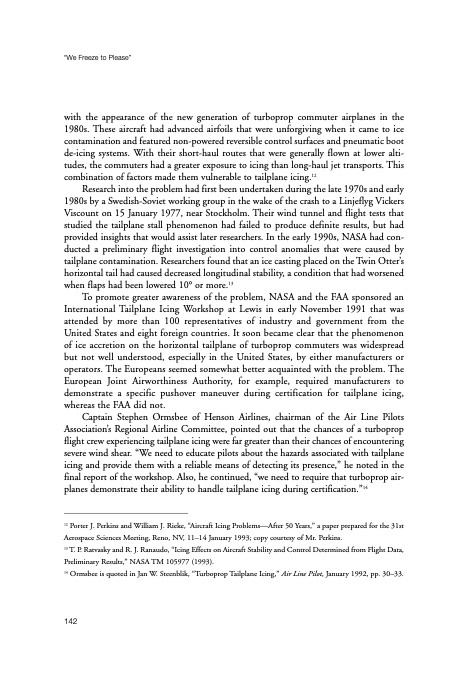
PDF Publication Title:
Text from PDF Page: 153
“We Freeze to Please” with the appearance of the new generation of turboprop commuter airplanes in the 1980s. These aircraft had advanced airfoils that were unforgiving when it came to ice contamination and featured non-powered reversible control surfaces and pneumatic boot de-icing systems. With their short-haul routes that were generally flown at lower alti- tudes, the commuters had a greater exposure to icing than long-haul jet transports. This combination of factors made them vulnerable to tailplane icing.12 Research into the problem had first been undertaken during the late 1970s and early 1980s by a Swedish-Soviet working group in the wake of the crash to a Linjeflyg Vickers Viscount on 15 January 1977, near Stockholm. Their wind tunnel and flight tests that studied the tailplane stall phenomenon had failed to produce definite results, but had provided insights that would assist later researchers. In the early 1990s, NASA had con- ducted a preliminary flight investigation into control anomalies that were caused by tailplane contamination. Researchers found that an ice casting placed on the Twin Otter’s horizontal tail had caused decreased longitudinal stability, a condition that had worsened when flaps had been lowered 10° or more.13 To promote greater awareness of the problem, NASA and the FAA sponsored an International Tailplane Icing Workshop at Lewis in early November 1991 that was attended by more than 100 representatives of industry and government from the United States and eight foreign countries. It soon became clear that the phenomenon of ice accretion on the horizontal tailplane of turboprop commuters was widespread but not well understood, especially in the United States, by either manufacturers or operators. The Europeans seemed somewhat better acquainted with the problem. The European Joint Airworthiness Authority, for example, required manufacturers to demonstrate a specific pushover maneuver during certification for tailplane icing, whereas the FAA did not. Captain Stephen Ormsbee of Henson Airlines, chairman of the Air Line Pilots Association’s Regional Airline Committee, pointed out that the chances of a turboprop flight crew experiencing tailplane icing were far greater than their chances of encountering severe wind shear. “We need to educate pilots about the hazards associated with tailplane icing and provide them with a reliable means of detecting its presence,” he noted in the final report of the workshop. Also, he continued, “we need to require that turboprop air- planes demonstrate their ability to handle tailplane icing during certification.”14 12 Porter J. Perkins and William J. Rieke, “Aircraft Icing Problems—After 50 Years,” a paper prepared for the 31st Aerospace Sciences Meeting, Reno, NV, 11–14 January 1993; copy courtesy of Mr. Perkins. 13 T. P. Ratvasky and R. J. Ranaudo, “Icing Effects on Aircraft Stability and Control Determined from Flight Data, Preliminary Results,” NASA TM 105977 (1993). 14 Ormsbee is quoted in Jan W. Steenblik, “Turboprop Tailplane Icing,” Air Line Pilot, January 1992, pp. 30–33. 142PDF Image | History of NASA Icing Research Tunnel

PDF Search Title:
History of NASA Icing Research TunnelOriginal File Name Searched:
sp4226.pdfDIY PDF Search: Google It | Yahoo | Bing
NFT (Non Fungible Token): Buy our tech, design, development or system NFT and become part of our tech NFT network... More Info
IT XR Project Redstone NFT Available for Sale: NFT for high tech turbine design with one part 3D printed counter-rotating energy turbine. Be part of the future with this NFT. Can be bought and sold but only one design NFT exists. Royalties go to the developer (Infinity) to keep enhancing design and applications... More Info
Infinity Turbine IT XR Project Redstone Design: NFT for sale... NFT for high tech turbine design with one part 3D printed counter-rotating energy turbine. Includes all rights to this turbine design, including license for Fluid Handling Block I and II for the turbine assembly and housing. The NFT includes the blueprints (cad/cam), revenue streams, and all future development of the IT XR Project Redstone... More Info
Infinity Turbine ROT Radial Outflow Turbine 24 Design and Worldwide Rights: NFT for sale... NFT for the ROT 24 energy turbine. Be part of the future with this NFT. This design can be bought and sold but only one design NFT exists. You may manufacture the unit, or get the revenues from its sale from Infinity Turbine. Royalties go to the developer (Infinity) to keep enhancing design and applications... More Info
Infinity Supercritical CO2 10 Liter Extractor Design and Worldwide Rights: The Infinity Supercritical 10L CO2 extractor is for botanical oil extraction, which is rich in terpenes and can produce shelf ready full spectrum oil. With over 5 years of development, this industry leader mature extractor machine has been sold since 2015 and is part of many profitable businesses. The process can also be used for electrowinning, e-waste recycling, and lithium battery recycling, gold mining electronic wastes, precious metals. CO2 can also be used in a reverse fuel cell with nafion to make a gas-to-liquids fuel, such as methanol, ethanol and butanol or ethylene. Supercritical CO2 has also been used for treating nafion to make it more effective catalyst. This NFT is for the purchase of worldwide rights which includes the design. More Info
NFT (Non Fungible Token): Buy our tech, design, development or system NFT and become part of our tech NFT network... More Info
Infinity Turbine Products: Special for this month, any plans are $10,000 for complete Cad/Cam blueprints. License is for one build. Try before you buy a production license. May pay by Bitcoin or other Crypto. Products Page... More Info
| CONTACT TEL: 608-238-6001 Email: greg@infinityturbine.com | RSS | AMP |